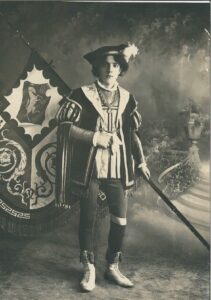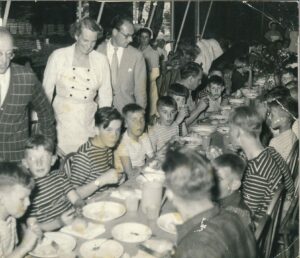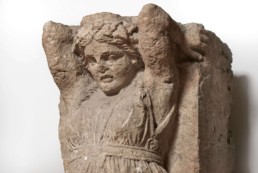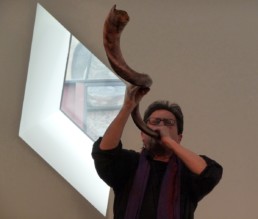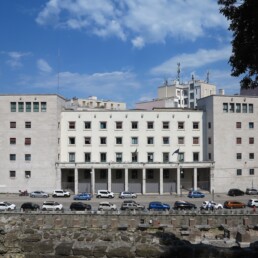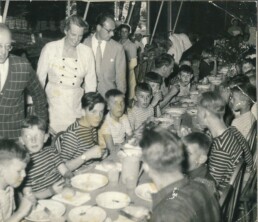Lecture on leather tanning in Greek antiquity
Wednesday 15 February 2023 at 6 pm
Villa Lante al Gianicolo
FROM SKINS TO LEATHER: TANNING IN ANCIENT GREECE
Dr. Petra Pakkanen
Finnish Institute of Athens
The lecture is organized in collaboration with Amici di Villa Lante al Gianicolo
Tanning and leather production in Roman antiquity has recently attracted increasingly scholarly attention. However, our knowledge on equivalent practices in Greek antiquity is far patchier and often ignored. This lecture provides an overview with insights to detail to tanning in Greek antiquity. It will cover terminological issues relating to skins, leathers and their processing, provides an overview of tanning procedures on the basis of ancient Greek textual, epigraphic, iconographic and material evidence, and discusses the connection between tanning and sanctuaries. In the end the questions concerning tannery archaeology in Greece will be addressed.
Petra Pakkanen is the Director of the Finnish Institute at Athens. In her research she has specialist particularly in ancient Greek religion, its theoretical and practical aspects and has worked with the so-called ‘archaeology of cult’ also with reference to excavation projects in Greece. She has written extensively also on the theme of 19th-century philhellenism and its use in national discourses particularly in Northern Europe. Her current research interest concern leather production and the use of leather goods in ancient Greece, including the social and cultural aspects of tanneries and tanners.
To attend the event please register by filling out the registration form.
ArCHeoM 2023 Swiss Archaeology in the Western Mediterranean
16/02/2023 - h09:30/20:30 entrance Via Liguria, 20
Each year, Istituto Svizzero hosts the archaeology departments of Swiss universities, providing a platform for work and discussion to raise the profile of Swiss archaeological research in the Mediterranean region.
During this year’s conference, Swiss postdoctoral students have the opportunity to present their research projects in the Mediterranean region. Participants include professors and researchers of classical archaeology from the Universities of Basel, Bern, Fribourg, Geneva, Lausanne, Neuchâtel and Zurich.
The conferences will be held in German, French, English and Italian at Istituto Svizzero, via Liguria 20, Rome.
Registration recommended here.
A letter to Giacinto Celsi
24/02/2023 - The concert will take place at H18:00 at Istituto Svizzero, via Liguria 20, Rome.
Composer and musician Alvin Curran along with Sound Arts students from the Bern Academy of the Arts (HKB) will play the concert titled A letter to Giacinto Scelsi at Istituto Svizzero. This performance is part of a research project of the Sound Arts department at HKB together with the Fondazione Scelsi in Rome. Together, Curran and the students will channel their inner Scelsi to connect with this unique composer’s world.
Alvin Curran (1938) is an American composer, sound artist, writer, and educator who has lived in Rome for many years. Over the course of his vast career, he has created sound installations, solo performance pieces, radio works, choreographic works, environmental concerts, and music for string quartets, chamber ensembles, and saxophone quartets. Many of his works combine acoustic instrumentation with electronics and taped/sampled sounds, including voices, fog horns, and sounds from nature such as wind, water, and animal noises. He is the co-founder with Frederic Rzewski, Allan Bryant and Richard Teitelbaum of the Roman free improvisation group Musica Elettronica Viva.
Free entry, register to participate here.
Public Lecture: The Afterlives of Italy’s Fascist Party Headquarters from 1945 to Today
Since the end of the Second World War, Italians have faced the question of what to do with the physical traces of the Fascist regime, and whether to preserve, demolish, alter, or renovate buildings and monuments of that era. Fascist sites represent a difficult heritage that it is too important to be ignored, but which also elicits divisive and painful memories. The roughly 5000 headquarters of the Fascist Party, or case del fascio, which were built across Italy between 1922 and 1943, are a perfect example of that difficult heritage. Having been created to represent Fascist party, they became redundant after its dissolution. While they lost their original purpose, they were recycled to serve new uses. In taking on new meanings in the light of an evolving culture and politics, they became comfortably integrated into Italian towns and cities. The treatment of the case del fascio is emblematic of how Italy has dealt with its Fascist past across the postwar period. Today, as the rule of a far-Right government fuels anxieties around the lasting legacies of Fascism, the case del fascio illustrate the creative and complex ways in which those legacies have been handled.
About the speaker
Hannah Malone is Assistant Professor in Contemporary History at the University of Groningen. After completing a PhD at the University of Cambridge, Hannah worked as a research fellow and lecturer at the British School at Rome, Magdalene College Cambridge, the Freie Universität, and the Max Planck Institute for the History of Emotions in Berlin.
Her research uses architecture as a window onto the nature of memory and politics. She is author of a book entitled Architecture, Death and Nationhood: Monumental Cemeteries of Nineteenth-Century Italy (Routledge, 2017) and has recently completed the manuscript of a book on Fascist Italy’s military ossuaries (sacrari) of the First World War.
As NWIB Visiting Professor at the KNIR in 2023, Hannah will investigate what happened to Italy’s Fascist Party Headquarters (case del fascio) after the fall of Mussolini’s dictatorship in 1945.
Dr. Jan Bernard Gijsman has joined the team of the KNIR Bibliotheek
We are excited to announce that Dr. Jan Bernard Gijsman has joined the team of the KNIR Bibliotheek as a volunteer. He is working with Adrian Luijdjens' extensive photo collection.
On our website you can read more about Jan Bernard's first findings: https://www.knir.it/.../fotoarchief-adriaan-luijdjens/
